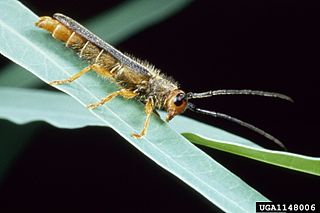
Euphorbia is a very large and diverse genus of flowering plants, commonly called spurge, in the family Euphorbiaceae. "Euphorbia" is sometimes used in ordinary English to collectively refer to all members of Euphorbiaceae, not just to members of the genus.

Weed control is a type of pest control, which attempts to stop or reduce growth of weeds, especially noxious weeds, with the aim of reducing their competition with desired flora and fauna including domesticated plants and livestock, and in natural settings preventing non native species competing with native species.

Euphorbia esula, commonly known as green spurge or leafy spurge, is a species of spurge native to central and southern Europe, and eastward through most of Asia north of the Himalaya to Korea and eastern Siberia. It can also be found in some parts of Alaska.

Aphthona is a genus of beetle, in the leaf beetle family Chrysomelidae, native to Europe and Asia. More specifically, Aphthona are flea beetles, meaning they have enlarged hind legs for jumping away from potential danger. There are some 300 species known worldwide.

Aphthona flava is a beetle of the genus Aphthona. It is native to Eurasia, and has been introduced into North America as a biocontrol agent for leafy spurge. Adults are brown and difficult to distinguish in the field from A. cyparissiae and A. nigriscutis. A. flava is still the dominant beetle at some Manitoba release sites, but it is relatively scarce in North Dakota and Minnesota. Besides Manitoba, it is widespread in Hungary and Italy.

Euphorbia heterophylla, also known under the common names of Mexican fireplant, painted euphorbia, Japanese poinsettia, paintedleaf, painted spurge and milkweed, is a plant belonging to the Euphorbiaceae or spurge family.

Euphorbia cyparissias, the cypress spurge, is a species of plant in the genus Euphorbia. It is native to Europe and was introduced to North America in the 1860s as an ornamental plant.

Euphorbia myrsinites, the myrtle spurge, blue spurge, or broad-leaved glaucous-spurge, is a succulent species of flowering plant in the spurge family Euphorbiaceae.

The flea beetle is a small, jumping beetle of the leaf beetle family (Chrysomelidae), that makes up the tribe Alticini which is part of the subfamily Galerucinae. Historically the flea beetles were classified as their own subfamily.
Camp Grafton is the main Army National Guard installation in North Dakota. The base, located near Devils Lake, North Dakota, was founded in 1904 as the Rock Island Military Reservation, but later renamed after Gilbert C. Grafton.

Hyles euphorbiae, the spurge hawk-moth, is a European moth of the family Sphingidae. It has been found in Pontresina, Switzerland. This hawk moth is used as an agent of biological pest control against the noxious weed leafy spurge, but usually only in conjunction with other agents. The larvae consume the leaves and bracts of the plant. The species was first described by Carl Linnaeus in his 1758 10th edition of Systema Naturae.
Leafy spurge may refer to several species of plant in the genus Euphorbia, including:
Aphthona abdominalis is a species of leaf beetle known as the minute spurge flea beetle. It was used as an agent of biological pest control against the noxious weed leafy spurge, but never established a viable population.
Aphthona cyparissiae is a species of leaf beetle known as the brown dot leafy spurge flea beetle. It is used as an agent of biological pest control against the noxious weed leafy spurge.
Aphthona czwalinae is a species of leaf beetle known as the black leafy spurge flea beetle. It is used as an agent of biological pest control against the noxious weed leafy spurge.

A weed is a plant considered undesirable in a particular situation, growing where it conflicts with human preferences, needs, or goals. Plants with characteristics that make them hazardous, aesthetically unappealing, difficult to control in managed environments, or otherwise unwanted in farm land, orchards, gardens, lawns, parks, recreational spaces, residential and industrial areas, may all be considered weeds. The concept of weeds is particularly significant in agriculture, where the presence of weeds in fields used to grow crops may cause major losses in yields. Invasive species, plants introduced to an environment where their presence negatively impacts the overall functioning and biodiversity of the ecosystem, may also sometimes be considered weeds.
Aphthona lacertosa is a root-feeding flea beetle of the genus Aphthona. It is one of 5 Aphthona spp. that has been used in Alberta, Canada to control leafy spurge, an invasive plant that reduces pasture quality and degrades natural habitats.
Aphthona nigriscutis is a root-feeding flea beetle of the genus Aphthona. It is one of five Aphthona spp. that has been used in Alberta, Canada to control leafy spurge, an invasive plant that reduces pasture quality and degrades natural habitats. It, along with A. lacertosa, is one of only two biocontrol agents thought to be effective against leafy spurge.

Chamaesphecia hungarica, the Hungarian clearwing moth, is a moth of the family Sesiidae. It is native to the south-eastern Czech Republic and Slovakia, Austria, Hungary, Serbia and Croatia. It was originally approved for introduction into the United States in 1993. It has been released at several leafy spurge-infested sites in Montana and North Dakota.

Oberea erythrocephala, the leafy spurge stem boring beetle or red-headed leafy spurge stem borer is a species of longhorn beetle that is a biological control agent for leafy spurge. It is an effective killer of the pest but only works on certain strains of leafy spurge, namely the subgenus Esula of the genus Euphorbia. Because of this, the beetle is considered as secondary in leafy spurge control to five species of Aphthona flea beetle.













